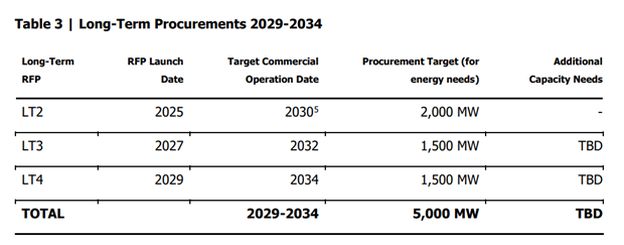n an effort to provide energy project developers, financiers and other stakeholders more regulatory certainty the IESO issued its Resource Adequacy Update on December 11 ("RA Update"), in response to the Minister of Energy's letter dated December 7, 2023, addressing emerging electricity needs beginning in 2029. The need for new energy in Ontario is driven primarily by agricultural, manufacturing and population growth amidst a tenuous future for natural gas-fired generation and as large nuclear units undergo significant refurbishment.
Highlights in the RA Update include a 5,000 MW procurement target for new energy supply beginning in 2029 and growing through the 2030s, to be met by way of the following series of competitive long-term (LT) RFPs1:

Of note, the LT2 is anticipated to solve for electricity needs emerging between 2029 and 2031 and will thus likely offer flexible commercial operation dates. The IESO is also considering taking a bifurcated approach to the LT2 RFP that separately evaluates long lead time resources under a bespoke procurement target (e.g. 500 MW/2,000 MW).
While the LT RFPs will continue to target non-emitting new-build resources2, medium-term (MT) RFPs will be offered in alternate years to incent existing non-emitting sources (primarily wind solar PV) to remain after their respective supply contracts expire between 2026 and 2035. The IESO is hopeful that these variable generation sources will become eligible to participate in the pending MT and LT procurements by pairing with the almost 2,500 MWs of storage capacity recently procured through the E-LT1 and LT1 (particularly since standalone storage will be treated as capacity only resources and therefore ineligible to participate in the 2029-2034 energy procurements).
In addition to the emerging energy need, the RA Update states that some residual capacity needs may remain in 2029/2030 depending on the mix of resources acquired to meet energy needs, and that capacity needs are also expected to grow more significantly through the 2030s. Unlike in the E-LT and LT1 RFPs, distributed energy resources (DERs) will be permitted to participate in the 2029-2034 energy procurements.
While future capacity procurements are likely to continue to entail pre-proposal submission deliverability testing requirements, future energy procurements may not require the same degree of congestion management. Increased daily demand shifting to overnight periods - exacerbated in part by increased EV charging and the introduction of an overnight ultra-low electricity rate - has created a more consistent need for energy as compared to capacity used to meet system peak demand periods. Further, recently procured standalone storage may create more siting flexibility for renewable generation resources thereby easing competition for interconnection availability. Post-proposal submission deliverability evaluation, however, is still expected to be conducted by the IESO.
Notwithstanding the Ministry's intent to provide more certainty to energy project developers and investors, the RA Update rightly notes that the 5 TWh procurement target is a conservative estimate based on a number of variables including:
- the likelihood that newly procured assets are able to enter service as anticipated, in the volumes procured;
- growing pains inherent to new technologies, including their ability to participate and operate effectively in the real-time market and contribute to system needs immediately after entering service;
- the ability for aging assets (including FIT-contracted wind and solar) to continue to contribute to resource adequacy in a consistent manner;
- government policy and pending legislative considerations inherent to some thermal generation (i.e. natural gas generation)
Finally, the RA Update acknowledges the significant impact that parallel considerations such as Indigenous community and municipal council support and buy-in, may have on the ability to satisfy the province's growing electricity demand needs. To help mitigate against these risks, the IESO encourages early municipal council engagement and revisiting agricultural and Crown land use restrictions and permitting. The RA Update also reiterates the need to expedite transmission system planning and buildout to support the net new energy producing resources.
Unless these and other related measures are undertaken in coordination with municipal and federal governments, the 5 TWh energy procurement target alone is unlikely to provide project owners and investors with sufficient regulatory certainty to commit to continuing operation of their existing facilities coming off contract and/or deploying the necessary capital to build new supply resources to meet Ontario's future electricity needs.
Footnotes
1. IESO Resource Adequacy Update to the Minister dated December 11, 2023 Evaluating Procurement Options for Supply Adequacy, at Table 3, page 12.
2. Eligibility of facility repowering, uprates and expansions are still to be determined.
To view the original article click here.
The content of this article is intended to provide a general guide to the subject matter. Specialist advice should be sought about your specific circumstances.


